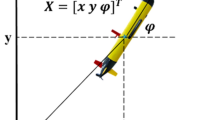Abstract
Autonomous underwater vehicles (AUVs) usually work without any commands from remote control and finish tasks on their own. Path planning is necessary and very important. The Glasius bioinspired neural network (GBNN) model has already been applied to path planning of AUVs. Generally, the model divides the environment space into many rectangular grids. However, the triangular and hexagonal grids can also be adopted to divide the environmental space. To compare among the three different map partitions, analysis and simulations are performed. The path length, steering and speed varies are compared while the receptive range of AUV keeps the same. Analysis shows that the triangular grid may be the worst and the hexagonal grid may be the best. However, in the simulations, there is a path oscillation problem in the hexagonal partition, which makes the path longer and zigzag. On the other hand, the triangular gird also has some advantages, such as minimum turning angle, while the rectangular grid can make a balance.
Access this chapter
Tax calculation will be finalised at checkout
Purchases are for personal use only
Similar content being viewed by others
References
Keane, J.R., et al.: Autonomous underwater vehicle homing with a single range-only Beacon. IEEE J. Oceanic Eng. 45(2), 395–403 (2020)
Kulkarni, I.S., Pompili, D.: Task allocation for networked autonomous underwater vehicles in critical missions. IEEE J. Sel. Areas Commun. 28(5), 716–727 (2010)
Panda, M., Das, B., Subudhi, B., Pati, B.B.: A Comprehensive review of path planning algorithms for autonomous underwater vehicles. Int. J. Autom. Comput. 17(3), 321–352 (2019). https://doi.org/10.1007/s11633-019-1204-9
Zeng, Z., et al.: A survey on path planning for persistent autonomy of autonomous underwater vehicles. Ocean Eng. 110, 303–313 (2015)
Garcia, M., et al.: Dynamic graph-search algorithm for global path planning in presence of hazardous weather. J. Intell. Rob. Syst. 69, 285–295 (2013)
Qin, Z., et al.: A novel path planning methodology for automated valet parking based on directional graph search and geometry curve. Robot. Auton. Syst. 132, 1–12 (2020)
Soltani, A., et al.: Path planning in construction sites: performance evaluation of the Dijkstra, A*, and GA search algorithms. Adv. Eng. Inform. 16(4), 291–303 (2002)
Petillot, Y., et al.: Underwater vehicle obstacle avoidance and path planning using a multi-beam forward looking sonar. IEEE J. Oceanic Eng. 26(2), 240–251 (2001)
Zelinsky, A.: A mobile robot exploration algorithm. IEEE Trans. Robot. Autom. 8(6), 707–717 (1993)
Feizollahi, A., Mayorga, R.V.: Optimized motion planning of manipulators in partially-known environment using modified D* Lite algorithm. WSEAS Trans. Syst. 16, 69–75 (2017)
Aitsaadi, N., et al.: Artificial potential field approach in WSN deployment: cost, QoM, connectivity, and lifetime constraints. Comput. Netw. 55(1), 84–105 (2011)
Chen, L., et al.: A fast and efficient double-tree RRT*-like sampling-based planner applying on mobile robotic systems. IEEE/ASME Trans. Mechatron. 23(6), 2568–2578 (2018)
Kaplan, A., et al.: Time-optimal path planning with power schedules for a solar-powered ground robot. IEEE Trans. Autom. Sci. Eng. 14(2), 1235–1244 (2017)
Tewolde, G.S., Sheng, W.: Robot path integration in manufacturing processes: genetic algorithm versus ant colony optimization. IEEE Trans. Syst. Man Cybernet. Part A Syst. Hum. 38(2), 278–287 (2008)
Azzabi, A., Nouri, K.: An advanced potential field method proposed for mobile robot path planning. Trans. Inst. Meas. Control. 41(11), 3132–3144 (2019)
Cheng, C., et al.: A genetic algorithm-inspired UUV path planner based on dynamic programming. IEEE Trans. Syst. Man Cybernet. Part C (Appl. Rev.) 42(6), 1128–1134 (2012)
Sun, Z., et al.: Path planning for GEO-UAV bistatic SAR using constrained adaptive multiobjective differential evolution. IEEE Trans. Geosci. Remote Sens. 54(11), 6444–6457 (2016)
Song, Q., et al.: Dynamic path planning for unmanned vehicles based on fuzzy logic and improved ant colony optimization. IEEE Access 8, 62107–62115 (2020)
Koh, K.C., et al.: A neural network-based navigation system for mobile robots. In: Proceedings of 1994 IEEE International Conference on Neural Networks (ICNN'94), pp. 2709–2714, IEEE, Orlando (1994)
Panagiotopoulos, D.A., et al.: Planning with a functional neural network architecture. IEEE Trans. Neural Netw. 10(1), 115–127 (1999)
Glasius, R., et al.: A biologically inspired neural net for trajectory formation and obstacle avoidance. Biol. Cybern. 74(6), 511–520 (1996)
Yang, S.X., Meng, M.: Real-time collision-free path planning of a mobile robot using a neural dynamics-based approach. IEEE Trans. Neural Netw. 14(6), 1541–1552 (2003)
Chen, M., Zhu, D.: A workload balanced algorithm for task assignment and path planning of inhomogeneous autonomous underwater vehicle system. IEEE Trans. Cogn. Dev. Syst. 11(4), 483–493 (2019)
Yan, M., Zhu, D., Yang, S.X.: A novel 3-D bio-inspired neural network model for the path planning of an AUV in underwater environments. Intell. Autom. Soft Comput. 19(4), 555–566 (2013)
Chen, M., Zhu, D.: Optimal time-consuming path planning for autonomous underwater vehicles based on a dynamic neural network model in ocean current environments. IEEE Trans. Veh. Technol. 69(12), 14401–14412 (2020)
Acknowledgements
This work was supported in part by the National Natural Science Foundation of China (52001195, U2006228, 61873161, 51575336, U1706224, 91748117), the National Key Project of Research and Development Program (2017YFC0306302), the Natural Science Foundation of Shanghai (19ZR1422600), Shanghai science and technology innovation action plan (18550720100) and Shanghai Science and Technology Innovation Funds (18550720100, 20dz1206700).
Author information
Authors and Affiliations
Corresponding author
Editor information
Editors and Affiliations
Rights and permissions
Copyright information
© 2021 Springer Nature Switzerland AG
About this paper
Cite this paper
Chen, M., Zhu, D., Chu, Z. (2021). Comparison of GBNN Path Planning with Different Map Partitioning Approaches. In: Liu, XJ., Nie, Z., Yu, J., Xie, F., Song, R. (eds) Intelligent Robotics and Applications. ICIRA 2021. Lecture Notes in Computer Science(), vol 13016. Springer, Cham. https://doi.org/10.1007/978-3-030-89092-6_47
Download citation
DOI: https://doi.org/10.1007/978-3-030-89092-6_47
Published:
Publisher Name: Springer, Cham
Print ISBN: 978-3-030-89091-9
Online ISBN: 978-3-030-89092-6
eBook Packages: Computer ScienceComputer Science (R0)




